Stories
Raewyn Alexander
1955-

Like many entrepreneurial designers living in 1970s Auckland, Raewyn Alexander was a stallholder at Cook Street Market. The markets provided a space to sell and earn an income as well as providing a supportive and creative community - a scenario that could be hard to find as a working artist, designer or maker.
Raewyn designed and made clothes to sell at the market. She had learnt to sew at an early age, growing up in an extended family of women who loved sewing. They made costumes to wear in school productions, Sunday school plays and performances for the neighbours. Later, as a teenager, there were frequent parties or church dances to attend, each deserving the latest fashion look. Standards were high. Raewyn’s Aunty Betty made ten uniforms in red velvet trimmed with gold cord and tassels for the Hamilton Citizens’ Band Marching Team, winning the prize for best uniform in the 1950/1951 season.
But despite Raewyn’s love of fashion, she didn’t enrol in formal fashion study after high school. The sewing classes at Maeroa Intermediate and later Hamilton Girls' High School, were far from inspiring. Raewyn recalls her teacher’s old-fashioned ideas and her horror when her students selected paisley print fabrics to make shirt dresses in class, with enormous white or coloured ruffles down the front.
Instead she studied briefly at Teacher Training College in Hamilton and Elam Art School, before choosing instead to work three jobs to save to travel overseas with her then boyfriend, Mal Licious of punk band The Scavengers. One of those jobs was her first stint as a stallholder at Cook Street Market.
Raewyn shared a stall with her friend, Robyn Rastrick, where they sold their own designs, as well as second-hand garments and accessories. Raewyn had been making clothes and costumes for performers, including Judge Hoffman’s guitarist and bass player, and later, Mal Licious, so it seemed natural to expand her range. "I designed things I thought would sell, designs you could not easily get here, based on shapes noted in overseas fashion from magazines like The Face. My shapes were more simple than what sold overseas, to suit our casual En Zed style." Favoured designs were layered short skirts, appliqued jackets, simple tops with applique of angular women's faces or foliage-like Matisse-ish shapes and none of the garments were labelled.
After about four months she had saved enough to go overseas and she spent a year travelling around Europe with her boyfriend, drawing much of what they saw, especially in museums, or unusual places. Remembered highlights included a costume museum in Athens, an Iron Age village reconstruction in Denmark, and a huge exhibition of Viking jewellery, carving, longboats and more in London. Living in the fashion district, The King’s Road in Chelsea and around London for six months inspired her too. By then their interest had moved on from punk to new wave, a look that was influential when she returned to New Zealand in 1981.
After regrouping at her parents’ house, Raewyn moved back to Auckland and secured another stall at Cook Street Market. This time she labelled her designs. The first, Threadz, included an image of a gorgeous women’s profile, lipsticked mouth open and a dense thread sharply angling out, spelling the name in jazzy handwriting. Her graphic designer partner drew this for her.
Describing herself as unaware of the importance of brand, Raewyn kept changing the name of her label, finally settling on Daredevil. This is the label she became known for when, in 1983, she set up Zephyr, a fashion collective, with a fellow stallholder, Alison Hutton.
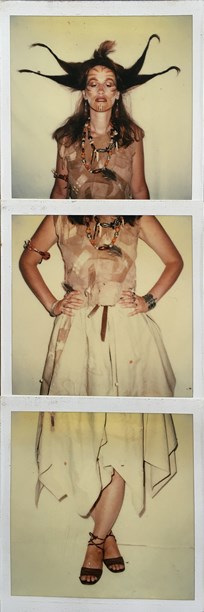
Raewyn models a top made from patchwork chamois off-cuts and a skirt with a handkerchief hem. The photos - inspired by the pastiche work of David Hockney - were taken for the Appliqué Party exhibition at Zephyr’s shop in Elliott Street. Image © Raewyn Alexander.
Zephyr’s huge workroom and shop was located on the third floor of 29 Elliott Street. The building was due for demolition so the rent was cheap. Alison’s search for like-minded designers resulted in a group including Clemency Thompson of Lollie Devine, Alan Franks, Bob Withers and Georgina Barrows of Silkworms and Sackcloth. Their first parade, ‘Filthy Rich, Pretty Poor’ they held in the cleared workroom in September 1983. They hired chairs and a catwalk, made enormous coloured paper flowers stapled to the newly painted pale green walls, rehearsed their models, and put on quite a professional and exciting event. They received great publicity, and sold many garments after the show.
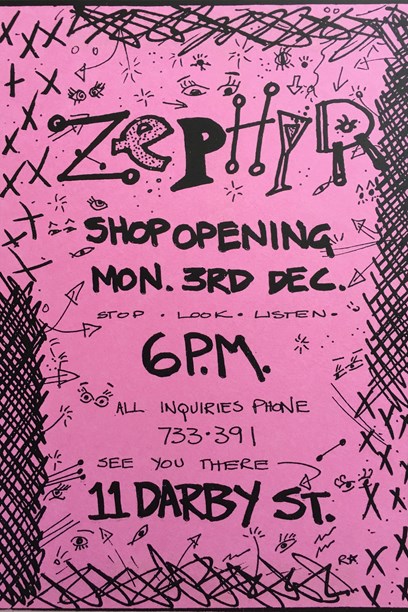
Flyer for Zephyr's shop opening at 11 Darby Street. Image © Zephyr.
Alison left the collective after a short time, going on to open Alison Hutton Design on Ponsonby Road after studying intensively with Perrin McLeod. New members included Jane and Anne Andrews who had the label Cannibal Sisters, Merle, Ann Houston and Walter Davy of Cocoon, (who had previously worked with Tigermoth).
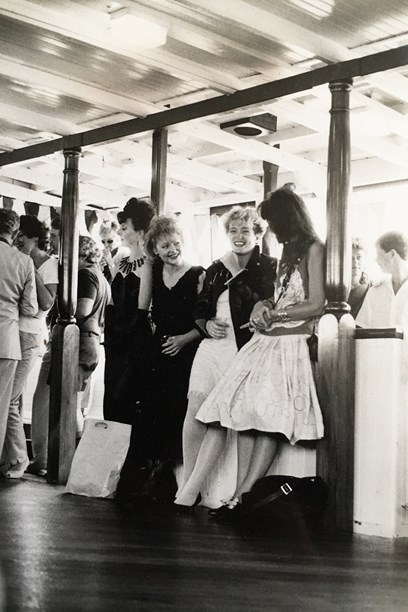
Clemency Thompson, Jane and Anne Andrews and Raewyn Alexander at a fashion show on the newly refurbished Kestrel ferry to celebrate the launch of Alison Hutton's new Ponsonby store. Image © Raewyn Alexander.
In 1983 Zephyr moved to a ground floor space on Darby Street. The increase in rent at their new premises and a general lack of knowledge about retail business led to the breakup of the collective in 1987. They sold the fittings and handed over the lease to another label, Chlorophyll.
Raewyn continued to make clothes and costumes, which she sold in local stores including Design Doris de Pont, Virus, Oi Clothing and Phenomena. She eventually found a new workspace in City Workshops, with Margaret Graham. Then they graduated to a workroom on the 3rd floor, and shop on the 5th floor of the Security Building on Queen Street. Known as 'Italy Upstairs', the sign downstairs went through several re-jigs, eventually decorated with pink plastic roses given to them by Judy Darragh.
When Margaret left to go overseas Raewyn rebranded the store with her own label, A. Ray. Raewyn describes this time as "enormously hard work". When her daughter Geneva was born in 1989, she took one week off and returned to the shop with her baby. They lived in Quay Street then, in a converted office space, and walked to the shop. But by the early 1990s, she was losing money and made the heart-breaking decision to close A. Ray.
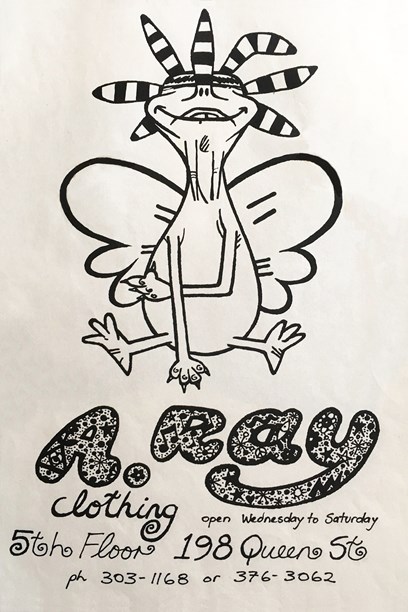
A poster to promote Raewyn's label A. Ray. Image © Raewyn Alexander.
Raewyn concentrated on designing costumes and clothes for friends, and began writing and teaching. In 2004 she completed a degree in International Communication at Unitec - a social sciences degree that included papers in intercultural communication, marketing, languages, and relationship management. She continues to use fabrics and costume for performance or art.
Raewyn designed her 'Costume in which to flee from intolerable difficulties into the comfort of illusion' for 2016’s Intellectual Fashion Show with her daughter, Geneva Alexander-Marsters - another generation with design and sewing expertise.
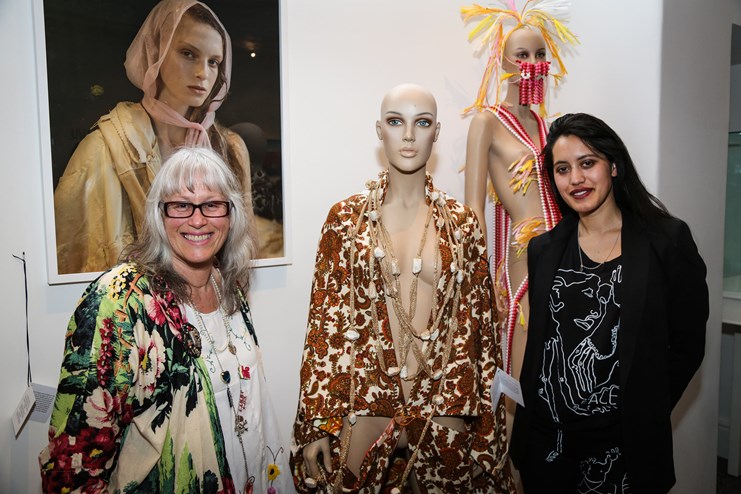
Raewyn Alexander and Geneva Alexander-Marsters with their costume, October 2016. Photo by Sharlene Ferguson.
Despite a long career of designing clothes, Raewyn says she never really believed she was a fashion designer - more of an artist using fashion as a form of expression. She holds designers such as Zambesi, Ingrid Starnes, Backwater Clothing and Minnie Cooper in high regard. "Fashion is the most difficult kingdom of them all. So much hard work, which nevertheless has to look like fun and wearable to clients and fans."
Text by Kelly Dix.
Last published October 2016.